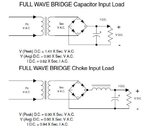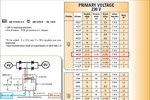d123
Advanced Member level 5
Hi,
I made a basic linear AC/DC power supply, and wanted to ask why my calculations, based on the Hammond Rectifier Relationships pdf were way off reality, not sure what I'm still getting wrong.
It's a dual secondary. 2VA. 2 x 12V AC secondaries. 83mA AC per secondary.
Transformer datasheet says VSec no load = 20V AC.
As I don't have 10mA slow-blow fuses I had to use a fast-blow 100mA on the primary side, beggars can't be choosers, eh!
I calculated 16V DC (12V AC x 1.41), but measured 23V - 24V after the filter capacitors with "no load" (as the 7805 + an LED don't seem to count?), down to 18.7V with the right load. Had to add the dropping resistor(s) to take the strain off the 7805 as I'd calculated about 12V in, not 23 or 18...
Calculated I DC = 0.62 x I Sec AC = 50mA per secondary if I sec AC is 83mA.
The maximum the circuit can produce is 42mA DC, and that after connecting the secondaries in parallel to maximise the transformer power (not double the voltage, but wanting to double the current) and at least get about 60mA out of the thing, but it's not happening, evidently at 42mA - Why is that possible, please? What may I have done wrong, or is it just that this type of supply has such low efficiency that that is about as good as can be expected?
I gather that from (admittedly only a couple of) articles and the Hammond power supply that uses an inductor/choke, that to maximise power that one is the only circuit to do so, capacitor filter alone places current and voltage out of phase, hence poor efficiency, and even so it seems the efficiency is still very poor with the choke - from what I read that soon this type of power supply won't pass (can't remember specifically) EU or international PFC standards...
Sorry for a "not this kind of question, again...," but would appreciate any wisdom regarding why the power supply turned out so feeble, thank you.
I made a basic linear AC/DC power supply, and wanted to ask why my calculations, based on the Hammond Rectifier Relationships pdf were way off reality, not sure what I'm still getting wrong.
It's a dual secondary. 2VA. 2 x 12V AC secondaries. 83mA AC per secondary.
Transformer datasheet says VSec no load = 20V AC.
As I don't have 10mA slow-blow fuses I had to use a fast-blow 100mA on the primary side, beggars can't be choosers, eh!
I calculated 16V DC (12V AC x 1.41), but measured 23V - 24V after the filter capacitors with "no load" (as the 7805 + an LED don't seem to count?), down to 18.7V with the right load. Had to add the dropping resistor(s) to take the strain off the 7805 as I'd calculated about 12V in, not 23 or 18...
Calculated I DC = 0.62 x I Sec AC = 50mA per secondary if I sec AC is 83mA.
The maximum the circuit can produce is 42mA DC, and that after connecting the secondaries in parallel to maximise the transformer power (not double the voltage, but wanting to double the current) and at least get about 60mA out of the thing, but it's not happening, evidently at 42mA - Why is that possible, please? What may I have done wrong, or is it just that this type of supply has such low efficiency that that is about as good as can be expected?
I gather that from (admittedly only a couple of) articles and the Hammond power supply that uses an inductor/choke, that to maximise power that one is the only circuit to do so, capacitor filter alone places current and voltage out of phase, hence poor efficiency, and even so it seems the efficiency is still very poor with the choke - from what I read that soon this type of power supply won't pass (can't remember specifically) EU or international PFC standards...
Sorry for a "not this kind of question, again...," but would appreciate any wisdom regarding why the power supply turned out so feeble, thank you.


